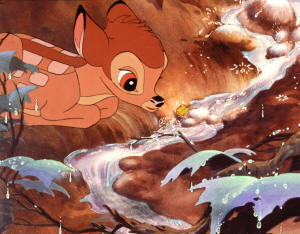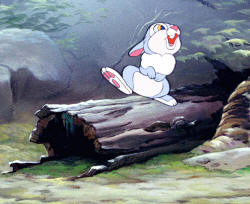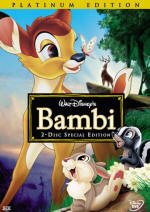Making movies. Enjoying movies. Remembering movies.
THE SCREENING ROOM
|
By
William Kallay

“Bambi” screened recently at the Academy of Motion Picture Arts & Sciences
in Beverly Hills, California. Not since being re-released in 1988 had the
film been seen on the big screen. And what a treat it was to see it again
with an audience of some of the greats who made the film come true.
Video Killed The Disney Theatrical Re-Release
Ever since moms in the 1980s began buying Disney classics on VHS for their
kids, the home video market has been saturated by nearly every animated
feature Disney release ever made. Go into almost any household in America,
it’s probably a good bet that there is at least one VHS copy, or several
Disney animated DVDs, lying around a house where children have been present.
These videos are a part of the American home video landscape.
The video revolution has been a boon for the Walt Disney Company ever since
the Michael Eisner/Jeffrey Katzenberg/Frank Wells era dawned in the
mid-1980s, with the release of “Pinocchio” (1940) on videotape in 1985.
Certainly, there were other video releases prior to their reign over the
magical vaults of Disney, including “Alice In Wonderland” and “The Love
Bug,” but nothing on the scale of “Pinocchio.” Since its release, almost
every Disney animated feature, and most shorts, have been on video in one
form or another. A treat for most people, the video versions of the
“classics” have provided endless entertainment for children and adults
alike. But what ever happened to the sensation of seeing one of these
classics with an audience?
For years, Disney’s policy was to re-release most of their more endearing
animated features in theatres. This gave new generations of children, and
adults, the opportunity to see these beloved films on the big screen. But
after Disney, and other studios, embraced the home video format, many of
these films have taken on different meanings. One of those was “Bambi,” Walt
Disney’s beautiful and wonderful film about the nature of growing up. What
video has taken away from this classic, and a number of other Disney
staples, is the way it unfolds on a screen and takes its short 70-minute
length to tell a story. Some movies simply work better on the big screen,
and “Bambi” is one of them.
The Return of Legendary Folk And Animation
Host and film historian, Leonard Maltin, introduced the evening’s audience
to a number of people who worked on the film during its production in the
early 1940s, to the restoration artists of today. On hand were Ollie
Johnston (animator), “voice talents” Peter Behn (Thumper), Cammie King
(young Faline), Andreas Deja (animator), Theo Gluck (Restoration Team) and
Steve Poehlein (Restoration Team).
To hear Ollie Johnston speak was a treat and a fortunate experience for
those in attendance. Many of the original animators, called affectionately
by Walt Disney, “The Nine Old Men,” have passed on in recent years. One of
those was Frank Thomas, Johnston’s close friend and frequent collaborator in
both film and print. And more recently, animator and story man, Joe Grant,
passed away in May. So it was indeed special for the audience to hear from
one of the people who helped create “Bambi.” When Johnston was introduced
onstage, he received a long standing ovation.
Johnston is well-known for his ability to infuse characters with life. As
was stated by Maltin, great animators bring two-dimensional drawings to
believability His animated characterizations included Baloo (“The Jungle
Book,” 1967), Smee (“Peter Pan,” 1953), Brer Rabbit (“Song Of The South,”
1946), and Thumper trying to eat a clover blossom in “Bambi.” His style is
of youthful innocence and even playfulness. This is well-illustrated in the
character of “Pinocchio,” where he’s brought to life by the Blue Fairy. The
little wooden boy is bright eyed and full of questions, as probably a
flesh-and-blood little boy would be if confronted by new and amazing events
and surroundings.
Maltin asked Johnston what made his characters come to life.
“He or she has got to live and breathe—live the part,” said Johnston. He
advised, “Don’t animate drawings. Animate feelings. All my characters I
believed in. They live in my own life.”
But Johnston was careful to give credit to his friend on his work on “Bambi”
“It wouldn’t have happened without a wonderful guy like Frank Thomas.”
Other topics included some reminiscing over roles in the film. Between the
tender ages of 5 and 7, Peter Behn recited those lines for a young Thumper,
“I’m thumpin.’ That’s why they call me Thumper!” His childlike charm endears
audiences to this day with the character of Thumper, a truly fun and
energetic kid who happens to be a rabbit. Behn, according the
IMDb, acted
only in this film.
 |
Cammie King played
the horse-riding daughter of Rhett Butler (Clark Gable) and Scarlet O’Hara
(Vivian Leigh) in “Gone With The Wind” (1939). She played the young Faline
in this film. She, too, had retired from movies in her childhood. It was
emphasized that the filmmakers of this movie wanted natural children, not
real actors, to play the voice talent. And in watching “Bambi,” it was the
right choice.
Andreas Deja was asked what scene stood out for him. His favorite is a
simple section of when Bambi, when very young, falls down and tries to get
back up. Deja liked the fact that when the fawn tries to get up, it’s to the
beat of music by Edward H. Plumb.
Seeing Bambi On The Big Screen
The Samuel Goldwyn Theatre is perhaps one of the finest facilities in the
world for watching film. Unless the Academy can’t find a suitable print,
more than likely, the picture and sound quality of seeing films here is
nearly perfect. The digitally restored and projected version of this film
looked extraordinary.
Undertaken by Disney, and headed by Gluck and Poehlein, the digital
restoration went back to the original nitrate negative. The negative was
scanned at 4K resolution and digitally cleaned and color enhanced at Lowry
Digital Images. Digital intermediates were done by Technicolor. Gluck and
Poehlein made sure that the digital version of the film wasn’t overly
enhanced to make the film too clean.
The picture looks very good, with seemingly natural colors, depth and
sharpness not seen before. The film, when shown from an original 35mm print,
contains dirt, scratches and specs on the original cels from the animation.
The film also appears to have a soft sheen to it. But in the digital
version, the picture is rock-solid and very bright, clean and clear to look
at.
It could be argued that Disney’s restoration team cleaned the film and sound
up too much. Perhaps. But without actually seeing a brand new 35mm print
struck from the original negative (providing that was indeed possible, and
the original negative was in excellent condition), or seeing the actual cels
and backgrounds of the film, it’s difficult to say how clean the original
picture was. I, for one, was skeptical of this new version of the film. I
prefer seeing the film’s original color and sharpness, if it’s available.
But the last time I saw it in a theatre, if memory serves, was in 1988 on a
small screen at a local multiplex. That’s not always the best way to judge
how a movie should look. I was also disappointed with some aspects on the
recent
“Mary Poppins”
DVD, in which a lot of the brightness was tweaked to a
point of certain scenes in the film being difficult to see on the screen.
But from watching “Bambi” digitally, it seems faithful to what the
filmmakers strove for. The colors in this version are rich, and there is
considerable depth to the opening forest scenes that hasn’t been seen by
audiences before.
 |
There is always the
possibility that modern day restoration teams can re-interpret how the
original filmmakers wanted a film to look. There is always the chance that
restoration efforts will change too much of how a film looks, sounds, or
plays. Given that modern technology can now re-align 3-strip Technicolor
movies so that the end result is “perfectly” projected, and that digital
“actors” can perform incredible stunts that mere humans can’t, filmmakers
and restorers can now do almost anything. Hopefully, Disney did consult the
surviving artists and original backgrounds/cels before they digitally
restored this film.
The audio, remixed by Keith Rogers and Terry Porter, was taken from magnetic
“stems” (dialogue, music and sound effects) and remixed in 5.1 surround
sound. No new audio was recorded to enhance the film. The result, in the
theatrical environment, is a faithful and natural sounding reproduction of
the soundtrack. There isn’t any annoying “modern thinking” that went into
the mix. And for those who are into “subwoofer action,” there is indeed some
present. (It should be noted that Disney’s sound department, for a time, had
some very good monophonic sound recordings of their early animated features.
A good example of this is “Pinocchio.”)
The Film
“Bambi” is certainly one of Walt Disney’s masterpieces. Simple in story,
high on charm, and pure in emotion, the film works on every possible
emotional level. Even though there are charming characters and moments
throughout the film, it’s still a very moving and haunting cinematic
masterpiece. The filmmakers didn’t clobber the audience over the head with
overly sweet sentimentality when Bambi’s mother is shot. He’s told his
mother is gone, sheds a tear, and the movie progresses. Yet, because of this
simple and quick storytelling, the audience can’t help but to be moved by
Bambi’s loss. It stays with you until well after you’ve left the theatre.
Children, as I witnessed during this screening, still turned to their
parents and asked, “Where’s Bambi’s mommy?”
The story of Bambi is so very basic and sweet that it could be easily
treated as simply children’s entertainment. But Disney and his staff were
far beyond just making kiddie films. It’s been said that Walt emphasized the
reality of life in this film, among others, and that kids should be given
truths about life and death. The audience is introduced to a young child who
has to go through the struggles of growing up, and “Bambi” tells it very
well.
For such a short film (at 70-minutes), “Bambi” loads a lot of charm, and
then art, into its timeframe. Perhaps the most endearing character in the
film, and most memorable, is of course, Thumper. The extroverted bunny is
street smart (or is he forest smart?), a wise-cracker and lovable at the
same time. He introduces Bambi to the wonders of the forest around him, and
how to experience life’s little pleasures, like eating the bulb from a
clover plant. His best scene, I think, it where he shows Bambi how to ice
skate. With minimal dialogue and humor, the scene is so well done. Thumper
takes time and patience to help his good friend learn to skate. What is
remarkable about this scene is that the action takes its time. There aren’t
a lot of fast cuts, and no need to add a lot of dialogue. The scene unfolds
as we watch Thumper unwrap Bambi’s hind legs, and tries to get him to stand
up on the ice. The scene builds to a hilarious conclusion when Bambi is
finally skating, and slides with Thumper across the ice into a snow bank!
The entire film is a work of art. There is such an amazing amount of color
and depth to each frame. Disney’s animators and artists took special care
and attention to the color palette of the forest and how real life animals
behave and move.
Though the scene itself of Bambi and Faline falling in love (“I Bring You A
Song”) drags the pacing of the film down a bit, it’s still a beautiful work
of art to watch. The wind blowing through the tall grass is a simple, but
effective example of the care and time that went into the film. When Bambi
leads Faline through the meadow, with moonlight bouncing off their backs,
it’s magical. Nearly every frame of this film shows just how talented and
meticulous the Disney staff was.
And the music of “Bambi” is extraordinary. Composed by Frank Churchill and
Edward Plumb, the music and songs advance the story and give the film a
solid musical foundation on which to play. Like the film itself, the musical
score is subtle when it has to be, and dynamic when it has to be. “Little
April Shower” is perhaps one of the best uses of how a song can begin a
scene, carry it along, then conclude it. Bambi is trying to fall asleep when
raindrops begin the fall. Along with the drops come musical cues, which like
the eventual heavy rainfall, will increase and develop into the song. The
downpour becomes heavy and dramatic as we watch Bambi’s startled reaction to
lightning and thunder. Each thunder clap is re-imagined through the use of
cymbals and a choral arrangement. Then when the storm subsides, so does the
music.
Passage Of Time
After 63 years, “Bambi” tells an incredible story of birth, life and death,
that it moves and charms audiences today. After seeing this film in a big
theatre with an audience, it makes me yearn for the return, even in limited
re-release, of Walt Disney’s masterpieces. My own daughter, 7, has yet to
experience these films in a proper environment. Home theatre is great, and
having a collection of Disney favorites is, too. But wouldn’t it be nice to
see “Snow White And The Seven Dwarfs” (1937) or “The Jungle Book” with an
audience again? Let the letter writing campaign begin! “Dear Disney and the
Academy of Motion Picture Arts and Sciences….”
IMAGES: © Buena Vista Home Entertainment, Inc. All rights reserved.
